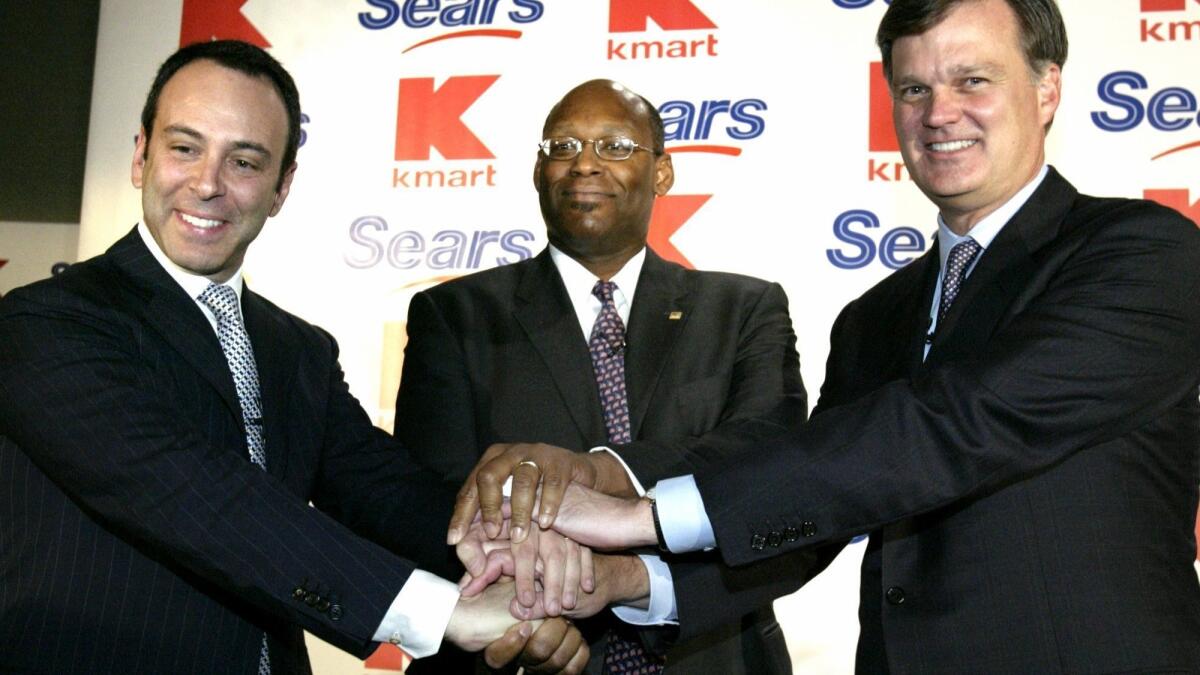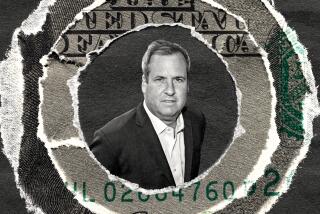Hedge fund whiz Eddie Lampert rode the worst trade of his life with Sears all the way down

- Share via
Bit by bit, the smart money deserted Edward Lampert.
Michael Dell, David Geffen, George Soros, the Ziff brothers — by 2012, all of them, and many more, had peeled away.
Not even Lampert’s friends could understand why the hedge fund manager, once hailed as a young Warren Buffett, clung to his spectacularly bad investment in Sears, a dying department store chain.
Granted, other hedge fund titans have blown it, such as Julian Robertson with US Airways and Bill Ackman with Herbalife. But few have ridden a disaster so publicly, over so many years, with such an iconic brand. It was hubris, many now say, and a failure to follow the investor commandment: Get out in time.
Lampert, who lost many millions as Sears Holdings Corp. shares ground down to pennies, kept throwing the company lifelines. From the moment he bought into what was then called Sears, Roebuck & Co., he also maneuvered to protect his financial interests. At times, he even made money.
He closed stores, laid off employees and, in what will surely be long remembered as the most unseemly element of the saga, carved out some choice assets for himself.
Until, at last, the reckoning. After 13 years under Lampert’s stewardship, Sears filed for Chapter 11 bankruptcy protection late Sunday night. And, once again, Wall Street is wondering what Edward Lampert will salvage for himself and his $1.3-billion fund, ESL Investments Inc., whose future may now be in doubt.
“He’s been doing a lot of financial engineering, but he’s just been moving around the deck chairs on the Titanic,” said Van Conway, a restructuring expert who worked on Detroit’s bankruptcy. “It looks like he’s played almost a full deck of cards by now.”
For years, Bankruptcy Court had been accepted by most everyone except Lampert as unavoidable. He refused to give in, proposing a plug-the-holes maneuver just two weeks ago, after years of machinations that kept the basic gears going even as the company was bleeding out.
At 56, he’s still a billionaire. A Sears bankruptcy isn’t likely to change that for Lampert, who agreed to step down as CEO as part of the reorganization but will retain his chairmanship.
Lampert has maneuvered out of tight spots before, most famously when he persuaded four men who kidnapped him in January 2003 to let him go after holding him for 30 hours, blindfolded and handcuffed, in a motel bathroom. But saving sinking Sears required more than fast talk.
His last idea was a debt restructuring that received little or no support from other creditors, who saw it as a scheme to allow ESL to be paid for Sears’ real estate, according to a person with direct knowledge of the situation. Part of this Lampert plan was to have unsecured creditors swap their debt for equity, a fool’s trade in the view of most analysts.
There’s no question Sears has cost him, and not only in reputation: He saw about $240 million worth of stock that he personally purchased evaporate as the shares tumbled. An additional $287 million that he received in compensation has all but disappeared. ESL has lost $65 million just this year.
The hedge fund’s assets plummeted to about $1 billion from $15 billion in 2006 as the portfolio shrank from half a dozen to the one massive crapshoot on Sears. The big-name investors exited, and so did Goldman Sachs Group Inc. clients who had come into ESL as part of a $3.5-billion capital raise in late 2007 and early 2008.
Still, as Sears’ major debt holder, with about half of the company’s $5.3-billion total, ESL saw a bit of upside, extracting more than $200 million in interest payments a year. And Lampert carved out what looked like — and in some cases might yet be — saves for himself, with spinoffs that gave him chunks of equity in new companies.
One was Seritage Growth Properties, the real estate investment trust that counts Sears as its biggest tenant and of which Lampert is the largest shareholder; he created it in 2015 to hold stores that were leased back to Sears — cordoning those off from any bankruptcy proceeding. He and ESL got a majority stake in Land’s End Inc., the apparel and accessories maker he split from Sears in 2014.

The Sears Canada Inc. gamble was a fumble; that spinoff began liquidating a year ago. Lampert and ESL together had almost $300 million in that stock and both rode it to zero, though they did pocket $25 million in special dividends.
The spinoffs robbed Sears of assets when it needed them, said Mark Cohen, a former CEO of Sears Canada and frequent Lampert critic who’s an adjunct professor of retail studies at Columbia University.
“This completely unconventional way of managing a business might have been an interesting alternative operating strategy were it not for the fact that it has been a colossal failure,” Cohen said.
Over the years of propping Sears up, Lampert threw his own money into the effort, and his friends and supporters said this wasn’t only in self-interest: He wanted to keep the lights on and people employed. He and ESL were willing to lend at much lower rates than others were demanding. He had Sears pay almost $2 billion into the unfunded pension plan in the last five years.
Nothing Lampert won out of Sears’ spinoffs was the result of special treatment, said Paul Holmes, a spokesman for ESL. “As we have said previously, the Land’s End and Seritage transactions were carried out on transparent terms that delivered value to all Sears shareholders, and every shareholder had the same opportunity to participate.”
The defeat of a bankruptcy filing won’t dull Lampert’s passion, according to people close to him. He’ll continue to lead his low-key billionaire life, reading, riding his racing bicycles and spending time on his 288-foot yacht. (Lampert named it the Fountainhead, after the 1943 novel by Ayn Rand, whose books glorify individualism and the pursuit of riches.)
Lampert started ESL — for Edward Scott Lampert — in 1988 after three years at Goldman. Richard Rainwater, who oversaw the Bass brothers fortune, staked him $28 million to get going.
By the time he was 43, he was a billionaire three times over. He hit home runs, the most impressive with the auto-parts retailer AutoZone Inc. and the car seller AutoNation Inc. Even with the Sears fiasco, an investor who has been with Lampert from the beginning would now still be enjoying an annualized return of about 12%.
He had what looked like another success on his hands in 2002, when he bought Kmart’s unsecured debt for about $700 million. Within two weeks, he’d orchestrated the retailer’s exit from bankruptcy and emerged as its biggest shareholder.
Kmart was throwing off cash back then, and Lampert masterminded the merger with Sears. It wasn’t immediately a disaster, but losses started piling up.
Sears rolled through four CEOs in eight years, and Lampert took over in January 2013. But he shows up at the headquarters outside Chicago only a few times a year. He prefers to beam in from his office in Florida; while he still owns a home in Connecticut, he lives most of the time in a $40-million estate on Indian Creek, an island near Key Biscayne that’s home to two dozen or so of Miami’s uber wealthy.
As he cut costs to the bone, he pitted executives against one another in a battle for scarce resources in a sort of retail Hunger Games, people who worked for him said. He ruffled feathers by being a micro-manager with little interest in heeding the advice of top executives, according to one former high-ranking employee, who like others interviewed for this story asked not to be named for fear of angering Lampert.
Perhaps his biggest misstep was thinking he could power through the recession. He had the opportunity to cancel a massive number of leases on Sears stores in the aftermath of the financial crisis, according to people familiar with the company. Instead, he renewed them.
Rainwater, who died in 2015, had pulled his money out of the fund when Lampert decided to move beyond picking stocks to takeovers and buyouts, thinking the young man wasn’t ready. Part of it, Rainwater told the Wall Street Journal in 1991, was what he saw as the downside to Lampert’s exceptional drive: “He’s so obsessed with moving in the direction he wants to move that people get burned, trampled on, run into.”
Those words now seem prophetic.
UPDATES:
10:55 p.m.: This article was updated with Sears’ filing for bankruptcy protection.
This article was originally published at 2:25 p.m., Oct. 12.
More to Read
Inside the business of entertainment
The Wide Shot brings you news, analysis and insights on everything from streaming wars to production — and what it all means for the future.
You may occasionally receive promotional content from the Los Angeles Times.










